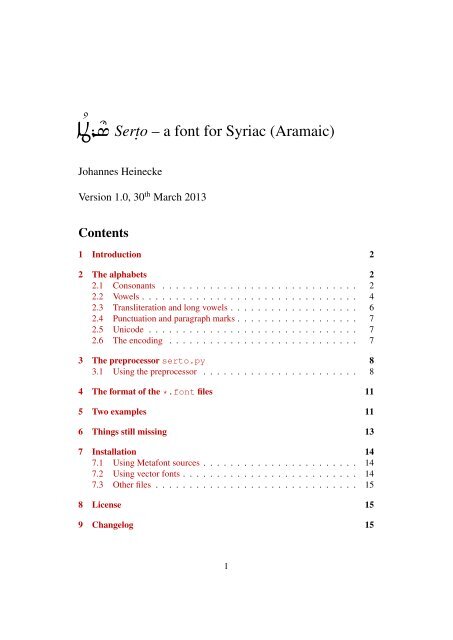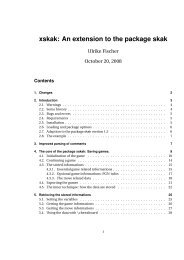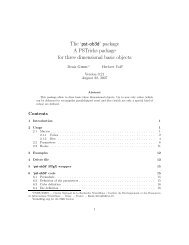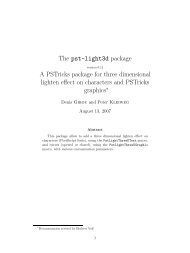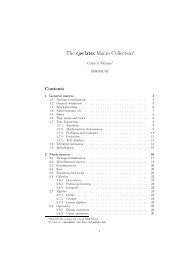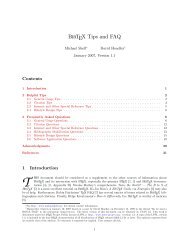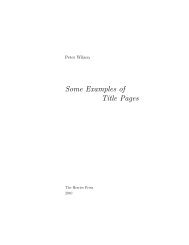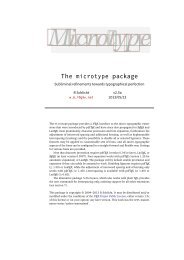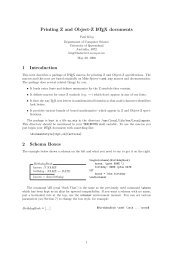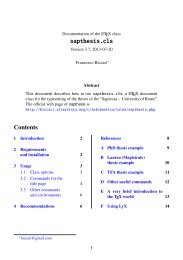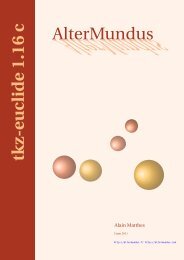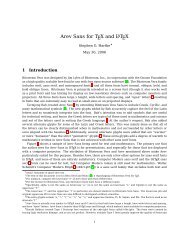Serto - A font for Syriac (Aramaic) - Johannes Heinecke
Serto - A font for Syriac (Aramaic) - Johannes Heinecke
Serto - A font for Syriac (Aramaic) - Johannes Heinecke
Create successful ePaper yourself
Turn your PDF publications into a flip-book with our unique Google optimized e-Paper software.
B¨ZŰ ˆĘ Serṭo – a <strong>font</strong> <strong>for</strong> <strong>Syriac</strong> (<strong>Aramaic</strong>)<br />
<strong>Johannes</strong> <strong>Heinecke</strong><br />
Version 1.0, 30 th March 2013<br />
Contents<br />
1 Introduction 2<br />
2 The alphabets 2<br />
2.1 Consonants . . . . . . . . . . . . . . . . . . . . . . . . . . . . . 2<br />
2.2 Vowels . . . . . . . . . . . . . . . . . . . . . . . . . . . . . . . . 4<br />
2.3 Transliteration and long vowels . . . . . . . . . . . . . . . . . . . 6<br />
2.4 Punctuation and paragraph marks . . . . . . . . . . . . . . . . . . 7<br />
2.5 Unicode . . . . . . . . . . . . . . . . . . . . . . . . . . . . . . . 7<br />
2.6 The encoding . . . . . . . . . . . . . . . . . . . . . . . . . . . . 7<br />
3 The preprocessor serto.py 8<br />
3.1 Using the preprocessor . . . . . . . . . . . . . . . . . . . . . . . 8<br />
4 The <strong>for</strong>mat of the *.<strong>font</strong> files 11<br />
5 Two examples 11<br />
6 Things still missing 13<br />
7 Installation 14<br />
7.1 Using Meta<strong>font</strong> sources . . . . . . . . . . . . . . . . . . . . . . . 14<br />
7.2 Using vector <strong>font</strong>s . . . . . . . . . . . . . . . . . . . . . . . . . . 14<br />
7.3 Other files . . . . . . . . . . . . . . . . . . . . . . . . . . . . . . 15<br />
8 License 15<br />
9 Changelog 15<br />
1
1 Introduction<br />
Serṭo is a <strong>for</strong>m of the alphabet used <strong>for</strong> <strong>Aramaic</strong> (a western semitic language)<br />
which has been spoken in the Near East since at least 1100 BC. More precisely,<br />
Serṭois used <strong>for</strong> <strong>Syriac</strong> which is the variant of <strong>Aramaic</strong> spoken since the second<br />
century AD. 1<br />
<strong>Syriac</strong> used other alphabets as well, notably Esṭrangelo, which is not (yet) contained<br />
in this package. Since Serṭo is as the Arabic alphabet a syllabic script, vowels<br />
are marked by diacritic marks above (or under) the consonantic letters. Modern<br />
<strong>for</strong>ms of <strong>Aramaic</strong> still use either Serṭo, the Chaldean alphabet or Esṭrangelo.<br />
Since <strong>Syriac</strong> split up in two main dialects in the fifth century AD, two differing<br />
systems of vowel-marking were established: Whereas the western dialect<br />
(Edessean) used Greek letters as vowel symbols (these are the only ones provided<br />
by this package <strong>for</strong> the time being), the eastern dialects uses dots to indicate the<br />
vowels (Chaldean vowels).<br />
This package enables you to typeset words or paragraphs in Serṭo using a preprocessor<br />
which chooses the correct letter <strong>for</strong>m depending on context. In order to<br />
typeset paragraphs the use of a recent version of pdflatex is needed, which can<br />
handle the right-to-left typesetting. For older version of L A TEX, the preprocessor<br />
must be used with the option -o (see section 3).<br />
This package also included an adapted version of a Chaldean <strong>font</strong> (thanks to Tony<br />
Khoshaba, who put this <strong>font</strong> to the Web).<br />
2 The alphabets<br />
Every letter in Serṭo (and some letters in the Chaldean alphabet) has several <strong>for</strong>ms,<br />
depending on its position in the word: An initial, medial or final <strong>for</strong>m. Since some<br />
letters do not connect to the following letter, there are isolated <strong>for</strong>ms as well (i.e.<br />
a letter which is not connected to the right nor the left). The coding column in the<br />
following table refers to the preprocessor described below (section 3). If you do<br />
not want to use the preprocessor, please refer to the encoding table in section 2.6.<br />
2.1 Consonants<br />
1 See Ungnad 1932, Brockelmann 1960, Costaz 1986 or Nöldeke 1986f (English translation<br />
Nöldeke 2001) <strong>for</strong> further in<strong>for</strong>mation on <strong>Syriac</strong>.<br />
2
serṭo <strong>for</strong>ms name translit. coding<br />
isolated<br />
final<br />
medial<br />
initial<br />
Chaldean<br />
A B A Ň ´tÄ ↪āla¯p ↪ ’<br />
C D E F |B IJk ˆF bēt ¯<br />
b 2 b<br />
|b 3 v v<br />
G H I J |G rẃ ¨J gāmal g g<br />
|U g .<br />
g<br />
|J j j<br />
K L D IJ ´t¨K dālat ¯<br />
M N H A ˆM hē h h<br />
O P O OÓ waw w w<br />
Q R Z zl´Q zayn z z<br />
d<br />
d<br />
S T U V |i IJk ˆV ḥēt ¯<br />
W X Y Z |W IJkẐ ṭēt ¯<br />
i j k l |I L¨l yād¯<br />
ḥ .h<br />
ṭ .t<br />
y y<br />
m n o p Q Ň ¨p kā¯p k k<br />
q<br />
h¯<br />
_k<br />
< č ˆk<br />
q r s t |L Lẃẗ lāmad¯<br />
l<br />
l<br />
u v w x m vk ˜x mīm m m<br />
y z Ą Ć > yP˝Ć nūn n n<br />
Č Ď Ě Ę |S IJów ˆĘ semkat ¯<br />
s<br />
s<br />
3
serṭo <strong>for</strong>ms name translit. coding<br />
isolated<br />
final<br />
medial<br />
initial<br />
Chaldean<br />
Ğ Ĺ Ľ Ł |E BˆŁ ↩ē ↩ ‘<br />
Ń Ň Ŋ Ő |P B ˆŐ pē p p<br />
|p f f<br />
Ŕ Ř s AˆK ¨Ŕ ṣādē ṣ .s<br />
Ś Š Ş Ť |V Ň ¨Ť qā¯p q q<br />
Ţ Ű Ű Ţ R Ÿl˜Ţ rīš r r<br />
İ đ đ İ r R<br />
Ů Ÿ Ź Ž |v zk ˜Ž šīn š ˆs<br />
Ż IJ T O ´Ż taw t t<br />
T<br />
t ¯<br />
_t<br />
2.2 Vowels<br />
The package allows to typeset the greek vowels or Chaldean vowels symbols. To<br />
have the vowel symbol written in inversed <strong>for</strong>m under the consonant, user upper<br />
case input.<br />
ATTENTION: I had to change the coding of zqā¯pā (¨_) from o to<br />
=a in order to accomodate the new letter ă_ (coding o). In texts<br />
encoded up to version 0.4 o has to be replaced by =a Sorry <strong>for</strong> any<br />
inconveniances.<br />
2 The beḡad¯ ke¯pat ¯ are not yet always processed. In general, the doubling of the consonant<br />
creates a B¨k¨˚Ź ˝Ť quššāyā in the syriac text and does not change the transliteration. On the other<br />
hand, a consonant followed by + will receive a Bö ¨˚pO˝Ţ ā and in the transliteration bgdkft<br />
will appear as<br />
rūkkāh¯ ¯pt.<br />
b¯ ḡd¯ h¯ 3 Modern <strong>Aramaic</strong> ¯<br />
dialects using the Chaldean alphabet have diacritic symbols (dots and tildes)<br />
which can be typeset directly.<br />
4
Greek Chaldean name transliteration coding<br />
´_ ‚ _ff B ¨V ¨IJŐ pt ¯ āḥā a a<br />
ˆ_ _ j<br />
A¨Ř ¨FŢ rb¯ āṣā e e<br />
Greek<br />
_ ”<br />
_ „<br />
coding<br />
A<br />
E<br />
˜_ _ ff<br />
A¨ŘËV ḥb¯ āṣā i i<br />
_ «<br />
I<br />
¨_ ˛_ B ¨Ŋ ¨ŤQ zqā¯pā ā =a<br />
_ »<br />
=A<br />
˝_ _ ff<br />
A ¨Ŕ¨ŘŁ ↩ṣāṣā u u<br />
_<br />
–<br />
U<br />
ă_ ‚ _ ā o<br />
ˇ_ Bŵˇ-¨kĘ syāmē P<br />
Note: The ḥb¯ āṣā and ↩ṣāṣā of the Eastern or Chaldean vowels do in general occur<br />
together with a mater lectionis: j ff<br />
t, ‚ Pt (or | ff<br />
IL, ‚ OL)<br />
The Bŵˇ-¨kĘ syāmē is processed as a vowel sign, even if it is not so from a linguistic<br />
point of view. Its coding P is chose because of its plural signification.<br />
If you do not want it over a letter, put it over a word stretch: The<br />
<strong>Aramaic</strong> at the beginning of this paragraph has been typset in the following:<br />
sy=a--Pme’.<br />
To avoid that the simple preprocessor does not mess about with vowels in ligatures<br />
(notably Lāmad¯ -ālaf and Ālaf-lāmad¯ the vowel must be set after both consonants<br />
of the ligature:<br />
l=a’ yields (incorrect) Bẗ lā but l’=a yields the vocalized<br />
ligature ¨ň lā<br />
’Al=Ah=a’ yields (incorrect) A ¨Nt A ↪alahā but ’la=Ah=a’<br />
» ”<br />
yields the vocalized ligature A ¨N ń ´ ↪alaahā »<br />
The Chaldean letters do not have this ligature. Instead, a tawālā ligature is provided:<br />
´@O˝I¨RP ˜S siprāyūta<br />
5
The default vowels are the greek-based vowels. In order to get Chaldean vowels,<br />
it suffices to add : in front of the vowel in coding. Thus you can set the most<br />
famous <strong>Aramaic</strong> phrase in all <strong>Syriac</strong> alphabets in either vowel system:<br />
eliy eliy lm=an=a’ s=ab=akt=aniy<br />
j˜Ć ¨IJoË ¨Ę B¨Ąẅt j ˜t j ˜tÂ<br />
:el:iy :el:iy lm:=an:=a’ s:=ab:=akt:=an:iy<br />
j ff<br />
Ć ˛ IJoĘ ˛Ę B˛Ą ˛wt j ff<br />
t j<br />
j ff<br />
tA j<br />
eliy eliy lm=an=a’ s=ab=akt=aniy<br />
|IѨTK ¨B ¨S A¨N ¨ML |I˜L |I˜LÂ<br />
:el:iy :el:iy lm:=an:=a’ s:=ab:=akt:=an:iy<br />
|<br />
ff IN ˛TK ˛B ˛S A˛N ML ˛ | ff<br />
ILA | j ff<br />
ILA j<br />
2.3 Transliteration and long vowels<br />
As mention in section 3 below, the preprocessor can produce a transliteration as<br />
well. The transliteration can be defined in the table used by the preprocessor<br />
serto.<strong>font</strong> and assyr.<strong>font</strong>. The current definition uses the transcription<br />
as shown in the tables in sections 2.1 and 2.2, with the exception of long vowels.<br />
In words using a vowel symbol together with a mater lectionis, the transliteration<br />
shows the transcription instead, <strong>for</strong> instance IJk ˆV transliterates as ḥēt and not ḥeyt<br />
¯ ¯<br />
and uBˆk ¨Ť qāyēm:<br />
Greek Chaldean transliteration coding<br />
B¨- A˛- ā =a’<br />
jˆ- |I- j<br />
ē ey<br />
Bˆ- A- j<br />
ē e’<br />
j˜- | ff<br />
I- ī iy<br />
P˝- O ff<br />
- ū uw<br />
6
2.4 Punctuation and paragraph marks<br />
<strong>for</strong>m<br />
coding<br />
<strong>for</strong>m<br />
coding<br />
. .<br />
: :<br />
! .X.<br />
" .:.<br />
# ::<br />
$ :-<br />
% .˜.<br />
& ./.<br />
2.5 Unicode<br />
This package has a limited Unicode support in that texts encoded in UTF8 can be<br />
directly typeset. In order to activate the UTF8 interpretation, either use UTF8 <strong>for</strong><br />
your whole document by declaring \usepackage[utf8]{inputenc} in the<br />
preamble of you document, or just put %\usepackage[utf8]{inputenc}<br />
somewhere at the beginning of your document.<br />
2.6 The encoding<br />
The following table shows the internal encoding of the defined letters of Serṭo and<br />
the Chaldean variant.<br />
0 1 2 3 4 5 6 7 8 9 A B C D E F<br />
”0n ´ ˆ ˜ ¨ ˝ ˚ ˇ ˘ ˛ ‚<br />
”1n ” „ « » – j ff<br />
”2n ! " # $ % & - .<br />
”3n :<br />
”4n A B C D E F G H I J K L M N O<br />
”5n P Q R S T U V W X Y Z _<br />
”6n i j k l m n o<br />
”7n p q r s t u v w x y z<br />
”8n Ą Ć Č Ď Ě Ę Ğ Ĺ Ľ Ł Ń Ň Ŋ Ő Ŕ<br />
”9n Ř Ś Š Ş Ť Ţ Ű Ů Ÿ Ź Ž Ż IJ İ đ §<br />
”An ă ń ň ŋ<br />
7
0 1 2 3 4 5 6 7 8 9 A B C D E F<br />
”0n ´ ˆ ˜ ¨ ˝ ˚ ˛ ‚<br />
”1n ” „ « » – j ff<br />
”2n $ & * -<br />
”3n < = ><br />
”4n @ A B D E G H I J K L M N O<br />
”5n P Q R S T U V W X Y Z<br />
”6n a b d e g h i j k m n o<br />
”7n p q r s t u v x y z |<br />
”8n<br />
”9n<br />
”An<br />
3 The preprocessor serto.py<br />
Typesetting of texts is still not yet possible with standard L A TEX, since the right-toleft<br />
typesetting (as <strong>for</strong> instance as in ArabTEX) has not yet been implemented. For<br />
the time being I propose a preprocessor (written in PYTHON 4 ) and pdflatex.<br />
I’m well aware that serto.py is not part of the most beautiful pieces of software<br />
code, on the contrary, it’s rather spaghetti code. Many things could have been in a<br />
more intelligent way, but it works, which is the most important thing. If you find<br />
the time to improve it please share your changes with me!<br />
3.1 Using the preprocessor<br />
The preprocessor is called with the L A TEX-file as argument:<br />
serto.py [-o] ppfilename.tex > filename.tex<br />
The resulting L A TEX-file can be L A TEXed as usually. Please make sure to have the<br />
\usepackage{serto} included in your preamble.<br />
The option -o is necessary if you use an older version of L A TEX which is not<br />
capable to typeset texts from the right to the left (TeX--XeTextension). The<br />
-o -option tells the preprocessor to inverse the letters on its own. In order to<br />
4 Every version from 2.4 onwards up to version 2.7 should do; Python 3.* however does not<br />
work PYTHON is an interpreted object oriented programming language available <strong>for</strong> many operating<br />
systems (http://www.python.org).<br />
8
typeset whole paragraphs pdflatex is the better solution. Usually it comes<br />
with every modern TEX-distribution. At least on Ubuntu 12.04 (texlive package),<br />
the standardly installed pdflatex behaves correctly.<br />
The preprocessor recognizes two types of commands. Within a single line you can<br />
put <strong>Syriac</strong> words between and : For example ser.t=a’<br />
becomes B¨ZŰ ˆĘ.<br />
and generate the enclosed part in Serṭo and generates a transliteration<br />
as well (mdiyt=a’ becomes AIJ »<br />
l˜Lx mdīta↪ “city”), whereas<br />
and can be used <strong>for</strong> parts only need in transliterated <strong>for</strong>m (ser.t=a’<br />
becomes serṭā). Since in transliteration a “neutral vowel” is needed, which does<br />
not appear in Serṭo, the code @ can be used: ˆs@m=a‘ produces<br />
ĹẅŽ še mā↩<br />
For multiple lines, start a block using 5 in a line on its own. This block<br />
can be closed by . If you need transliterated <strong>Syriac</strong>, use <br />
and . The commands / and /<br />
do not work properly with the -o option of the preprocessor and and older L A TEX.<br />
If you add TEX-commands in these blocks, a right-to-left typesetting version of<br />
L A TEX is obligatory.<br />
For the time being the preprocessor tries to set the hard sign B¨k¨˚Ź ˝Ť quššāyā on top<br />
of a consonant if the consonant is doubled in the input:<br />
q.tl yields rYŤ but q.t.tl yields rYŤ<br />
˚<br />
In cases where you need a B¨k¨˚Ź ˝Ť quššāyā without wanting to double the consonant,<br />
a * can be used after the letter to typeset a dot above a letter: h*=anon<br />
produces yăĆ ¨˚ M hānon and ˆsl=amk+on results in yăow ¨sŽ šlāmh¯ on<br />
To avoid a quššāyā (when you need to adjacent identical consontants, either use a<br />
vowel on the first, use the stretching symbol:<br />
maml’e yields ˆŋw ´x maml↪e<br />
mˆml’ yields ŋwx mml↪<br />
maml’e yields ÂLMḾ maml ↪e<br />
mˆml’ yields ALMM mml↪<br />
5 Using or implies the using of the -e option of the preprocessor<br />
serto.py. If you do not use the -e option the resulting L A TEX-file is likely to be syntactically<br />
incorrect.<br />
9
To get the soft sign Bö ¨˚pO˝Ţ rūkkāh¯ ā a + must follow the letter: ’ab+d=a’<br />
yields A¨LFÁ<br />
An ālaf is autmatically prefixed be<strong>for</strong>e an initial vowel:<br />
etqa.tel and ’etqa.tel both yield rŶ ´ŤŻÂ<br />
Sometimes the letter rīš is written with two points. To achieve this, use R instead<br />
of r in the input:<br />
ˆsapiyRe’ yields Aˆđk ˜Ŋ ´Ž<br />
Silent consonants have a bar B¨Ą ¨sYÉx aṭlānā (linea occultans) under the line<br />
mb¯<br />
which is produced by = just be<strong>for</strong>e the consonant (attention =a, however, yields Ä:<br />
’an=tt yields ˚ IJĆÁ<br />
In order to have the linea occultans on top of the letter, use ==:<br />
h==wiyt yields IJlÕ ˘M<br />
There is no automatic stretching yet, but the -- can be used to insert a “manual<br />
stretch”:<br />
napiyqt=a’ becomes A ¨IJŞk ˜Ŋ´Ć but na--piyq--t=a’ is<br />
printed as A ¨IJ-Şk ˜Ŋ-´Ć<br />
This works also <strong>for</strong> the Chaldean letters n:ap:iyqt:=a’ becomes<br />
A ˛TVI ff<br />
P ‚ N ff<br />
but n:a--p:iyq--t:=a’ is printed as A ˛T-VI ff<br />
P- ‚ N ff<br />
If you do not use the preprocessor, you can activate Serṭo by the command \serto.<br />
In this case you have to choose the correct letters yourself, and use the commands<br />
\upperserto{vowelnumber}{letter} or \lowerserto{vowelnumber}{letter}<br />
to set vowels. Please see the encoding table in section 2.6 <strong>for</strong> the correct vowel<br />
numbers.<br />
In order to get bold letters, you can use \sertob with or without preprocessor<br />
(see section 3 <strong>for</strong> more in<strong>for</strong>mation on the preprocessor.<br />
10
4 The <strong>for</strong>mat of the *.<strong>font</strong> files<br />
These files are necessary to tell the preprocessor where (in the <strong>font</strong>) a certain letter<br />
is found, and whether it has different <strong>for</strong>ms. The <strong>for</strong>mat is straight <strong>for</strong>ward, with,<br />
however, a few idiosynchrasies. In general there are two sections, the first (starting<br />
with a line #FONT) indicates which letter has which <strong>for</strong>m in which position and a<br />
second (#TRANS) to define the transcription.<br />
The first part consists of lines like the following<br />
b beth 66+124 66 66 66+124 1<br />
which reads, coding b is <strong>for</strong> the letter beth, its isolated <strong>for</strong>m is character 66 followed<br />
by character 124, its initial and medial <strong>for</strong>m is character 66, it’s final <strong>for</strong>m<br />
is character 66 followed by character 124 and the next letter (if any) must take it’s<br />
medial <strong>for</strong>m.<br />
However, if one of the four last columns has a value of −1, no <strong>for</strong>m is provided<br />
in the <strong>font</strong>. Values from 0 to 15 are reserved <strong>for</strong> accents/vowels above the line,<br />
values from 16 to 31 are reserved <strong>for</strong> vowels under the line.<br />
The lines<br />
˜ blank 32 32 32 32 0<br />
Q shadda 6 6 6 6 2<br />
-- stretch 45 45 45 45 1<br />
must not be deleted.<br />
The coding <strong>for</strong> digits (starting with 0 up to 9 in the first column cannot have the +<br />
in the position definition<br />
The transcription definition defines <strong>for</strong> each coding symbol (defined in the <strong>font</strong>section)<br />
a valid TEX-string to be used if transcription is needed, e.g.<br />
.t \d{t}<br />
i.e. the coding .t will be representend by ṭ in transcribed portions.<br />
5 Two examples<br />
Some of the following can be found in example.ptex which comes with this<br />
package.<br />
The following input was used to generate the output below:<br />
11
\documentclass[12pt,a4paper]{article}<br />
usepackage{serto}<br />
\begin{document}<br />
men qadiyˆse’ ho’ tetqadaˆs<br />
kmo’ dat+basb@suwn pagdo’<br />
\end{document}<br />
ŮĹ ´ŤŻ ˆŻ A ¨M BˆŹl˜L ´Ť z ˆx<br />
A¨LI ´Ő yP<br />
˝ĚEĚ ´FŻḰ Bẅp kmā dat ¯ basbe sūn pagdā<br />
iM O˝ŰĘAÓ i M PőEt ” :BÜl˜Ř´Ć LÉŁḰ uˆL ˆx :AIJ kY VḰ ÂLxP ˝p OŔV L ¨pO<br />
» «<br />
.yONlŃt<br />
» ň ” LÉŁḰ uˆL-- ˆx Bösẃt Pk˜ŁIJ ”<br />
ŽAÔ .Bös ´x u¨LŤ iM PlIJ «<br />
lAÓ<br />
:P ˝s ¨Őň T ´FKŻ K jt ” „ «<br />
IJl˜KOIJ ŽÂ P¨l¨KOIJ Ź ˆx AÖM ¨ň .Ű-- ´x zlˆK Bösẍ<br />
„ ”<br />
yP˝ĆA CˆŰ ´Ť .yP˝ĆA A ˆN ń ´ AÖM ¨ň .zkˆŁŻB ´xK zkŝlÁ A ˆN ń ´ j ˜t .Ű ´x BÜl˜Ř´Ć<br />
„ „ » »<br />
L ´V B¨ĆA ŠÊ ¨Ž ¨ň BˆĄ¨kYĚk ˜pḰ yO ˝MK ¨NFP ˝Ž ň<br />
»<br />
O .B ¨pŢ ¨Nt jt «<br />
.B¨Źx´Űt BẍL ´Ł B¨ĆA Š ˆŤĹx ¨ňK yO ˝NĄ ˆx<br />
The preceding text was set typeset with the following input:<br />
\documentclass[12pt,a4paper]{article}<br />
\usepackage{serto}<br />
\begin{document}<br />
<br />
wk=ad .hzaw kuwmd’e da.h.tIyt=A’ : medem<br />
da‘bad na.siy.h=a’: lAbkuwh=y=<br />
wa’sruwh=y= wa’ytIywh=y= qd=am malk=a’.<br />
we’ˆstA‘iyw lmalk=a’ me----dem da‘bad<br />
{\sertob l’Al=Ahayhwn}. m=alk=a’ deyn ’emar. l’=a hw=a’<br />
meˆstAwd=ay=aw ’eˆstEwdiyt lIy dtEdba.h<br />
l’Ap=aluw: na.siy.h=a’ ’emar. liy ’la=Ahe’<br />
’ayleyn dma’t‘eyn. l’=a hw=a’ ’la=Ahe’<br />
’Enuwn. qareb ’Enuwn lIy lh=ark=a’. \sertob wl’=A<br />
ˆsuwbh=adhuwn dakiys.ty=ane’ l’=a ˆs=abeq<br />
’=n=a’ .had menhuwn dl’=a mdaqeq ’=n=a’<br />
12
‘adm=a’ lramˆs=a’.<br />
<br />
\end{document}<br />
Replacing by results in this<br />
|IHOIT «<br />
IAÓ |IHO˝RSAÓ |IHO˝KBL AïI˜sŃ D ´BE´D mˆD ˆM AT IW i´D ÂDMO˝K OŹi D¨KO<br />
” » «<br />
-ḾÂ nIˆD A¨KL ¨M >OHI ´HL A L D ´BE´D mˆD-- ˆM A¨KLḾL OIẼT vAÔ A¨KLḾ m¨DV<br />
» ” ”<br />
nIˆLIÁ AĤĹ» A |I˜L RḾÂ AïI˜sŃ O˝L¨PA L |i ´BDT D |IL ” „ «<br />
TI˜DOT v OϨDOT v ˆM AÖH ÄL R-<br />
„ ”<br />
>O ˝HDḦBO ˝v A LO A¨KRḦL |IL » « >O˝NA |BˆR´V >O˝NA AĤĹ» A AÖH ÄL nIÊTAḾD<br />
„ „<br />
A¨NA |V ˆV´DM ÄLD >O ˝HN ˆM Dí A¨NA |V ˆB ¨v ÄL AˆNÏWSI ˜K´D<br />
A ¨vMŔL A ¨MDÉ<br />
The file was preprocessed using serto.py.<br />
6 Things still missing<br />
The todo-list is long. I try to add features etc. as soon as possible. Please tell me<br />
items you would like to have, but which are not yet on this list. Any volunteers<br />
are welcome!<br />
• proper typsetting of texts (without preprocessor, maybe in the ArabTEX<br />
package)<br />
• proper treatment of matrēs lectionis (long vowels)<br />
• proper treatment of the silent bar B¨Ą ¨sYÉx aṭlānā mb¯<br />
• proper treatment of beḡad¯ ke¯pat ¯ with hard sign B¨k¨˚Ź ˝Ť quššāyā and soft sign<br />
Bö ¨˚pO˝Ţ rūkkāh¯ ā<br />
• automatic transcription mode<br />
• interpunction<br />
• proper dealing with ligatures<br />
• B ¨sÎĆ´ŰYĘÂ ↪esṭrangelā<br />
13
• numbers the inputenc.sty package.<br />
• support <strong>for</strong> existing <strong>Syriac</strong> <strong>font</strong>s<br />
7 Installation<br />
The easiest way to install the <strong>font</strong>s and the preprocessor is by installing the debian<br />
package (this includes only the pfb, tfm and afm files <strong>for</strong> the <strong>font</strong>s), the needed<br />
styles and the preprocessor, but not the METAFONT sources:<br />
sudo dpkg -i serto-1.0.deb<br />
If you are not on a Debian or Ubuntu plate<strong>for</strong>m, you need to install manually from<br />
the .tgz file:<br />
7.1 Using Meta<strong>font</strong> sources<br />
Put the *.mf files into a subdirectory serto of your meta<strong>font</strong> branch in your<br />
texmf-directory. For example using the texlive distribution under Linux, you<br />
should put them into /usr/local/share/texmf/<strong>font</strong>s/source/serto/.<br />
Do not <strong>for</strong>get to call texhash in order to make the tex software find the newly<br />
installed <strong>font</strong>s.<br />
7.2 Using vector <strong>font</strong>s<br />
Using vector <strong>font</strong>s depends a little from the TEX-installation used, the following<br />
is tested <strong>for</strong> Ubuntu 12.04 and 10.04, it will probably work on Debian plat<strong>for</strong>ms<br />
as well, or other plat<strong>for</strong>ms using the texlive installation.<br />
• copy syriac.map to /usr/local/share/texmf/<strong>font</strong>s/map/dvips/config/<br />
• copy *.afm to /usr/local/share/texmf/<strong>font</strong>s/afm/syriac/serto/<br />
• copy *.pfb to /usr/local/share/texmf/<strong>font</strong>s/type1/syriac/<br />
• add Map syriac.map to /etc/texmf/updmap.d/10local.cfg<br />
• run sudo update-updmap<br />
• run sudo updmap-sys<br />
14
7.3 Other files<br />
The Stylefile etc. *.sty, *.fd go into a directory <strong>for</strong> stylefiles, e.g. /usr/local/<br />
share/texmf/tex/latex/serto/.<br />
The preprocessor serto.py and the encoding file serto.<strong>font</strong> somewhere<br />
where it can be found (e.g /usr/local/bin). They must reside in the same<br />
directory unless you specify in the environment variable SERTOFONTDIR the<br />
directory containing serto.<strong>font</strong> and assyr.<strong>font</strong>. Possibly you have to<br />
adjust the first line of the preprocessor #!/usr/bin/python if your python<br />
interpreter is somewhere else.<br />
8 License<br />
This Material is subjec to the LaTeX Project Public License 1.3 (http://ctan.org/<br />
license/lppl1.3).<br />
9 Changelog<br />
• Version 1.0<br />
– adding a character <strong>for</strong> the linea occultans above the letter<br />
– SERTOFONTDIR enviromnment variable to specify the directory of<br />
*.<strong>font</strong> files<br />
– some UTF8 support<br />
• Version 0.7<br />
– Chaldean vowels<br />
– Integration of the Chaldean <strong>font</strong> provided by Tony Khoshaba<br />
– Major adjustements to the serto.py preprocessor<br />
• Version 0.2, 0.3 and 0.4<br />
– can’t remember, didn’t keep track of changelog those days. . .<br />
• Version 0.1<br />
– Initial version<br />
15
References<br />
Brockelmann, Carl: 1960. Syrische Grammatik mit Paradigmen, Literatur,<br />
Chrestomathie und Glossar. Leipzig: VEB Enzyklopädie, 8th edn. 2<br />
Costaz, Louis: 1986. Grammaire Syriaque. Beyrouth: Dar el-Machreq. 2<br />
Nöldeke, Theodor: 1986f. Kurzgefaßte syrische Grammatik. (Neubearbeitung von<br />
Schall, Anton). Darmstadt: Wissenschaftliche Buchgesellschaft. 2<br />
Nöldeke, Theodor: 2001. Compendious <strong>Syriac</strong> Grammar. Translated by James A.<br />
Crichton. Winona Lake, IN: Eisenbrauns. 2<br />
Ungnad, Arthur: 1932. Syrische Grammatik mit Übungsbuch. München: Beck,<br />
2nd edn. 2<br />
16


